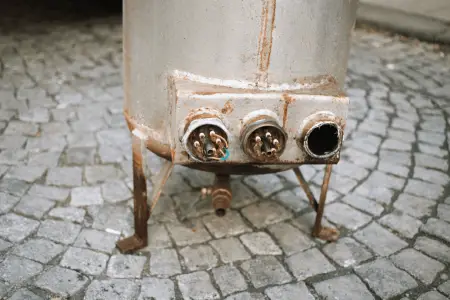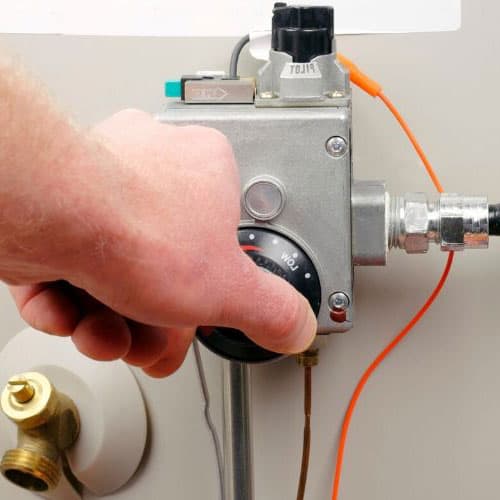When your water heater overheats and the water comes out scalding, it isn’t just inconvenient. It’s downright dangerous.
If you have kids, the risk of them getting seriously burnt when the water comes out too hot unexpectedly is something every parent should be concerned about.
So, how do you know what the problem is? It could just be a matter of some simple troubleshooting to get rid of the problem. Or, you may need a new water heater.
In this article, I will go over some of the reasons your water is too hot and how you can fix it.
Why is Your Water Scalding Hot?
The best way to figure out why the water is coming out so hot all of a sudden is to go through a process of elimination. We’ll go through all the possible reasons your water goes from cold to way too hot and then you just eliminate each one until you come up with the reason.
Check Temperature Setting
The most obvious reason the water is too high is that the thermostat is set way above what is comfortable. A good temperature is usually 120°F for most people. That way a little cold water can even out the temperature to what is comfortable.
If somebody was doing work around the heater or had to turn on the pilot light, then it is feasible that the temperature was changed.
The very first thing to check is the thermostat. If it is above 120°F and you didn’t set it that high then turn it down and see what happens. In fact, turn it down to a temperature lower than what you normally would.
Then, if the water is still coming out scalding hot, you can eliminate a simple mistake when setting the temperature as a reason for the problem.
The More You Know!
Check out this article on how to know when you need to replace your water heater!
If that doesn’t solve the problem then you should next check to see if the thermostat is faulty.
Faulty Thermostat
When your thermostat is not functioning properly, then it likely is due to the reset button. When the reset button isn’t working, it fails to shut off the heating element. That means that the water is constantly being heated with no shut off when it reaches the right temperature.
The only way to know if your thermostat is working is to test it with a multimeter. How to test a thermostat depends on the type of water heater, so I will give a brief rundown right below on how to test an electric or gas water heater thermostat.
Electric Water Heater
Before you do any kind of work or testing on your water heater, shut off the breaker to the heater. You do not want any risk of electrocution so be very careful that there is indeed, no power.
Open up the panel that will expose the thermostats. On electric water heaters, there are generally two. One for the upper heater and one for the lower.
Using a flat head screwdriver, turn the temperature up all the way on the upper thermostat. You’ll need a simple multimeter to measure any voltage from the thermostat. Set the scale on your multimeter to the RX1 setting.
- 【Range】 - KAIWEETS Digital Multimeter measures AC/DC voltage up to...
- 【Function】-Voltage Meter/ Current Meter/ Non-contact voltage tester/...
- 【Safety - Safety level】- EN61010-2-030 EN61010-2-033 CAT III 600V....
- 【Easy to Operate】- Backlight screen. LED backlight to work in poorly...
- 【After Sale】- KAIWEETS provides a 36-Month after-sale service, lifetime...
Place one probe on the terminal on the left. It should have a white wire. Then place the other probe on the terminal above the one with the white wire. The reading should show 0. Any other reading means the thermostat is not working.
Next, set the temperature on the upper thermostat to the lowest setting and repeat the process. It should still read 0.
Now, you’ll want to test the lower one. Set it to the highest temperature while the upper one is still on the lowest. There are only two screw terminals on the lower one, so you don’t have to worry about the color of the wires. Once again, this should read 0.
If you are getting any kind of voltage, then this is why your water is really hot. The heating element is constantly heating. This means you have to replace your thermostat.
Gas Water Heater
Testing the thermostat on a gas water heater is much easier. This thermostat is a valve in the shape of a dial. Adjust the temperature to its lowest setting and then run some hot water. If it still comes out hot then that means that it is faulty and needs to be replaced.
Technically, a gas heater uses a thermocouple which uses voltage to heat the water so it works slightly differently. It works in conjunction with the pilot so it shuts off the heater when the pilot light is out.

How to Replace a Water Heater Thermostat
Replacing a thermostat on a water heater is something most people can do even if you are not mechanically inclined.
As long as you have the circuit breaker turned off so there is no risk of electricity getting to the heater, then you can do this without any problem. You don’t even have to drain the tank.
I am omitting the instructions for a gas water heater as it involves dealing with a gas control valve. I think when you have to change any gas valves, it pays to have a professional so you don’t have the danger of a leak in case you make a mistake.
Before getting into the step by step instructions, here are the tools needed for changing the upper and lower thermostats on an electric water heater.
- Have both kinds of screwdrivers handy, a Philips and a flat head.
- A multimeter
- Upper thermostat
- Lower thermostat
Heads Up!
Thermostats for electric water heaters are universal so it doesn’t matter what brand you use.
Time needed: 1 hour.
Step By Step Guide On Replacing A Thermostat
- Be Safe
Shut off the breaker that goes to the water heater.
- Open the panel
If you closed up the panel after you did the test, then take it off again now to expose the thermostats.
- Take a picture
Take a picture of the thermostat before you take it apart. You want all the colored wires to go to the right screw terminal. This way you don’t have to try to remember.
- Removal
Unscrew the terminals to loosen the wire and retaining clip that makes the connection. Be very careful to not bend or remove the clips from the wire. If it comes loose, it won’t allow the current to pass through. Remove the thermostat from the chamber and set it aside.
- Install the new thermostat
Using your picture for reference, attach the retaining clips of the corresponding wire to the terminal and tighten the screws.
- Remove the lower one
Do the same process for the lower one, which is much easier as it only has two connections.
- Set temperature
Set the temperature on the lower thermostat to less than 120°F. Replace the compartment door.
Here is a quick video on how to do it with written steps right after.
Once you have everything buttoned up, flip the circuit back on and let the tank heat up for about two hours. Then check to see if the temperature is correct.
If it still comes out scalding hot then you may also need to replace the Temperature and Pressure Valve. Read below to learn more about that.
The More You Know!
What happens when you aren’t getting enough hot water? Click that link to read more about it!
Pressure Relief Valve Blocked
The Temperature and Pressure Relief valve aka TPR, is important in regulating the water temperature. If it is blocked or faulty, then the water just keeps on heating no matter what the thermostat is set to.
Testing the TPR is easy.
There is a lever on top of the valve that can be opened just by lifting it up. When you lift the lever, it should release air and water through the drainage pipe it is connected to. If the pipe goes down into a drain and you can’t see the opening, then remove the pipe and place a bucket underneath the valve to catch any hot water.
Be very careful doing this to avoid getting seriously burnt.
If you lift the lever and no water comes out, or it is just a trickle then your valve is blocked and needs to be replaced.
How to Replace TPR Valve
- Provides fully automatic self-closing temperature and pressure relief...
- A 2-in-1 temperature and pressure relief valve with copper alloy body, a...
- Proven accurate thermostat with special thermo-bonded coating which must be...
- Temperature relief: 210 degrees F (99 degrees C), pressure relief range: 75...
- The wetted surface of this product contacted by consumable water contains...
Replacing a TPR valve is also very easy and does not require a plumber. To do this yourself I added a video to show you how.
How to keep your water heater from overheating
Often, an overheating water heater could have been prevented. Yes, they get old and parts wear out, but before that point arrives, it pays to try to prevent it from happening before its time.
Some routine maintenance can do a lot to prevent that scalding hot water from happening.
For instance, one of the biggest reasons that a water heater starts overheating the water is due to limescale build up. If you have hard water, then there is calcium and magnesium building up on the heating element and other parts like the TPR valve.
If you are flushing your water heater once per year, it will keep it running properly and prevent any hard water scaling from messing with the heater.
FAQ About Scalding Hot Water
Your water heater should never be hot to the touch. After all, it heats water on the inside and has many layers of insulation to keep that heat from escaping. If your water heater is hot, then there is a problem.
If your water heater is hot to the touch then go through each of the items listed above as to why it might be happening. Flush your water heater to remove any sediment. And if nothing works then you need to replace it.
It’s unlikely, but still possible for a water heater to explode. This happens mostly when the TPR valve is blocked as it makes the heater produce hot water without stopping. This then creates steam inside the tank which will eventually cause a rupture and explosion.
Check your TPR valve once per year to make sure it is not blocked and is working properly.
If you have frequent fluctuations in temperature, then that means that you either have a faulty water mixer in the shower plumbing or the pipes were incorrectly fitted. This is not usually a problem with your water heater.
Conclusion
Resolving an overheating water heater is an urgent matter that requires your immediate attention. It can be as simple as replacing a faulty thermometer. But it could also be a more serious issue that requires professional help.

Nick Lopresti is the founder of YourH2Home and a home improvement expert. He has years of experience writing about various home improvement topics, mostly as it pertains to water systems.







